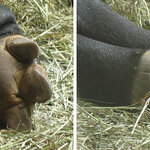Ecology & Zoology

It's two inches long, is shaped like a phallus and is commonly associated with wood. A middle school joke? No, it's a new species of stinkhorn mushroom discovered on the African island of Sao Tome and named after Robert Drewes, Curator of Herpetology at the California Academy of Sciences.
Phallus drewesii belongs to a group of mushrooms known as stinkhorns which give off a foul, rotting meat odor. There are 28 other species of Phallus fungi worldwide, but this particular species is notable for its small size, white net-like stem, and brown spore-covered head. It is also the only…

If you're a man, somewhere at some time some woman has said you just don't make love long enough. Okay, for some men all women have said that. But there are other extremes as well. Male flies of the species Drosophila montana are all about reproductive success so they keep going ... and going ... and going. And there's an evolutionary reason.
Researchers writing in the BMC Evolutionary Biology say that that females engaged in extended intercourse wait longer before they mate again, increasing the first fly's chances of fathering offspring.
Dominique Mazzi,…

Some enterprising scientists at NOAA have studied the health of animals suffering from bacterial infections by studying shrimp running on a treadmill.
I don't think this is recent news, but I just heard about it today and the video is too cute to pass up if you haven't seen it before, so check it out.

Paleontologists and some in biology have long believed that modern birds are the direct descendants of ancient, meat-eating dinosaurs.
Researchers at Oregon State University contend they have made a fundamental new discovery about how birds breathe and have a lung capacity that allows for flight – and the finding means it's unlikely that birds descended from any known theropod dinosaurs.
It's been known for decades that the femur, or thigh bone in birds is largely fixed and makes birds into "knee runners," unlike virtually all other land animals, the OSU experts say. What was just…

Is it a pig? A rhino? A zebra? Heck if I know. But it's really freaking weird looking, that's for sure.
The headline in the NY Times article, "New Research on Malaysia's Odd, Elusive Tapir" caught my attention, mostly because I had no idea what the heck a tapir is. Still don't, really. The Wiki entry attempts to clarify:
A large browsing mammal, roughly pig-like in shape, with a short, prehensile snout. Tapirs inhabit jungle and forest regions of South America, Central America, and Southeast Asia. There are four species of Tapirs, being the Brazilian tapir, the Malayan tapir, Baird's tapir…

Bats, unlike most animals, don't primarily use their voices for communication. Instead, they use echolocation to navigate their surroundings but they can also use it, and the characteristics of other bats' voices, to recognize each other, according to a study by researchers from the University of Tuebingen, Germany and the University of Applied Sciences in Konstanz, Germany.
The study published June 5 in PLoS Computational Biology, explains how bats use echolocation for more than just spatial knowledge and it might also help explain how some bats travel at high speed, at night, in…

New research shows that when two species of stickleback fish evolved, different genes in each species caused the loss of their pelvises and body armor. Researchers say they were surprised because they expected the same genes would control the same changes in both related fish.
Thank you. Thank you very much.
The new study focused on "convergent evolution," which is when the same trait evolves independently in different species or in separate populations of one species. A key question has been whether two species use the same gene or different genes when they evolve the same…

Comic books have warned us time and time again to keep villains away from radiation. It only makes them stronger. Researchers at University of Delaware have discovered that ultraviolet radiation from the sun increases the plant-destroying powers of the common reed, making it an invasive archnemesis to its wetland plant victims.
Phragmites australis is a giant among weeds—its bamboo-like stalks reach up to 20 feet in height. It grows to high density on land, in shallow water, and even as an aquatic plant in floating mats. Like most weeds, reeds do their best to fulfill a…

"We were on a break," is just an excuse likely to get you yelled at today but a new study at the Smithsonian Tropical Research Institute in Gamboa, Panama says there may be some long-term value in it - at least if you are an ant.
Fungus-farming ants have cultivated the same fungal crops for 50 million years, they say. Each young ant queen carries a bit of fungus garden with her when she flies away to mate and establish a new nest. Short breaks in the ants' relationship with the fungus during nest establishment may contribute to the stability of this long-term mutualism.
Ants in the…

The International Institute for Species Exploration at Arizona State University and an international committee of taxonomists – scientists responsible for species exploration and classification – today announce the top 10 new species for 2009, consisting of those described in 2008.
Part 1 and Part 2
How were the Top 10 chosen?
An international committee of experts, chaired by Janine N. Caira of the University of Connecticut, selected the top 10 new species for this year's list. Nominations were invited through the species.asu.edu Web site and also generated by institute staff and…